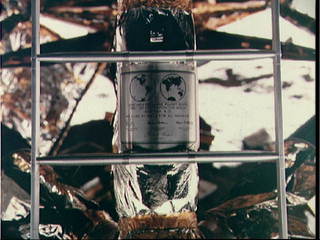A couple months ago I mentioned that Richard Nixon’s name would be long-remembered because it’s engraved on the Apollo 11 plaque on the airless surface of the moon. I started wondering how long the plaque would actually last and did some research, but for some reason I didn’t post what I found. I can’t find the links to my sources, but here’s what I wrote about it:
On Earth, a plaque like that on Apollo 11 would be subject to erosion by wind and rain. The wind and rain would also carry pollution and other corrosive chemicals which would be deposited on the plaque and eat it away. The moon, on the other hand, has no atmosphere, so there’s no wind or rain or flowing water to damage the plaque. It could last a long time, except for a source of erosion we don’t encounter on Earth: Micrometeorites.
The space between the planets is hard vacuum, a harder vacuum than we can create in earthbound laboratories, but it’s still filled with with very, very small dust particles and even individual molecules floating free. Anything moving through interplanetary space collides with these dust particles at speeds of several miles per second.
The Earth itself collides with hundreds of tons of space dust every day. However, all this dust hits the atmosphere first and slows to a crawl, eventually settling to the surface. All but the largest rocks will lose their orbital speeds in the atmosphere and drop like, well, like rocks.
The Earth’s moon, on the other hand, has no atmosphere at all to protect it, so even invisibly small dust particles will smack into the surface at several miles per second. These are called micrometeorites to differentiate them from meteorites large enough to survive the plunge through the Earth’s atmosphere.
The continuous lunar micrometeorite storm is mostly insignificant. Astronauts walking around on the moon would have been pelted constantly, but even at a 50 miles per second, the impact of a few molecules would have been unnoticable. However, over time, these dust particles would pit whatever they strike, eventually wearing it down, much as wind can erode away a rock.
Except much slower. From a paper about the design of the Message From Earth plaque on the Pioneer spacecraft, I found an estimated wear rate of about 1 angstrom per year in our solar system. An angstrom is a ten-billionth of a meter. For comparison, Niagra Falls erodes away at the rate of about 1 meter per year. It would take cosmic dust more that twice the age of the Earth to erode that same distance.
This is just a rough estimate, of course. The estimate for Pioneer is for small objects like man-made satellites drifting through space. The moon is large enough to have meaningful gravity, and it will pull in dust from the space around it, increasing the erosion rate. On the other hand, if you look at this image from NASA, it’s clear that the plaque isn’t just set on the surface of the Moon, it’s mounted on one of the landing legs of the Lunar Excursion Module.
That could shield the plaque from some of the dust, reducing erosion. For the sake of this article, let’s just assume the one-angstrom-per-year estimate is good enough.
If the engraving on the Apollo 11 plaque is a reasonable 1/10th of a millimeter deep, it will take a million years to wear away Richard Nixon’s name.
To put that in perspective, I think the oldest people whose names we know are the Egyptian Pharohs, a comparatively recent 6000 years ago.


Leave a ReplyCancel reply